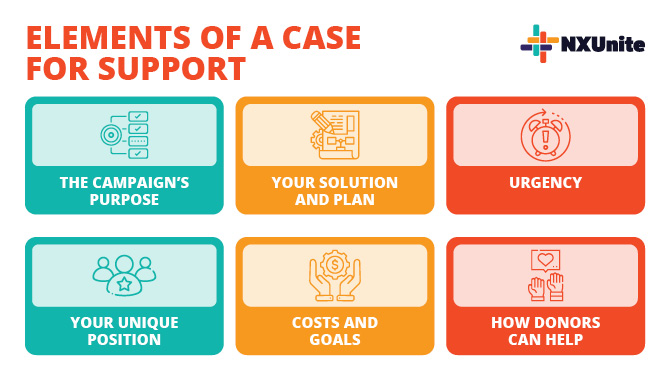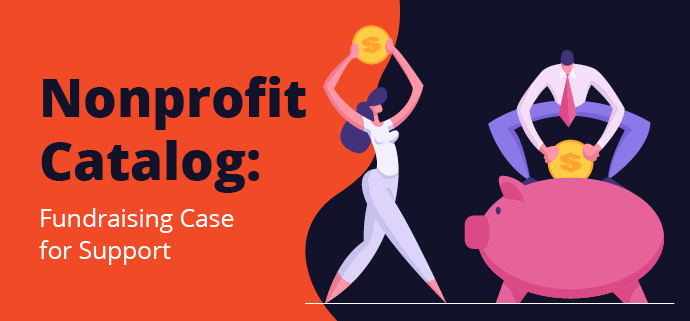Fundraising Case for Support — Nonprofit Catalog
When asking potential donors to support your cause, you need to present them with compelling reasons why — What challenge are you working to overcome? What are your nonprofit’s plans to tackle it? How will donations drive impact towards that goal?
These questions and more should be answered in your case for support.
What is a case for support?
A case for support is your core message and set of reasons why potential supporters should donate to your current fundraising campaign. An effective case for support lays out exactly what donations to your campaign will accomplish so that donors will feel motivated to give.
A case for support is typically distilled into a central document and adapted into a variety of printed and digital supporting documents, mailers, slide decks, and more. It provides your fundraising team with the central narrative and key details they need, ensuring that all messaging (whether in conversations with donors or in broad marketing materials) is fully aligned with the campaign’s purpose and goals.
Essential Elements of a Case for Support
To create a compelling argument for your campaign and inspire donations, clearly communicate these essential elements in your case for support:

- The campaign’s purpose. What’s the challenge you’re working to address? Why does it matter?
- Your solution and plan. How will your nonprofit address this challenge? What impact will your campaign have on your community?
- Urgency. Why is now the time for your campaign and proposed solution?
- Your unique position. Why is your organization up to the task? How have you driven impact in the past?
- Costs and goals. How much will your plan cost? How much money do you need to raise to cover those costs? How will you raise that money from various sources?
- How donors can help. What are the ways that donors can help drive impact via your campaign?
Underpinning these different elements, your case for support needs to clearly reflect your nonprofit’s unique voice, vision for the future of your community, and your priorities as an organization. The exact format and sections you use might vary based on the fundraising context, but if you can clearly show donors everything they need to know about your plan and why your nonprofit is worthy of support, you can drive amazing results.
When to Develop a Nonprofit Case for Support
Nonprofits most commonly create cases for support for large-scale campaigns (like capital campaigns) to help clarify their messaging while discussing the project with high-impact prospects. But cases for support can be extremely helpful in all kinds of situations Here are a few examples:
- Campaign-specific case for support. This sets out the campaign’s purpose, goals, impact, and how donations will drive that impact.
- Prospect-specific case for support. This document is highly tailored to a single prospect to reinforce their connection to your mission.
- Event-specific case for support. This resource can be created to establish standard messaging to be used for an event, like a large annual gala.
- General case for support. An all-purpose case for support more broadly explains your mission and how donations drive it forward. It can be used for general fundraising campaigns and adapted for more specific contexts.
How to Develop a Nonprofit Case for Support: 5 Steps
According to the fundraising experts at Graham-Pelton, these are the 5 key steps for developing a compelling case for support:
1. Define the purpose and audience.
Determine the specific context for this case for support—for instance, a specific campaign, individual prospect, event, or general use case—and its intended audience.
It’s important to understand who you’re hoping to motivate with your case for support so you can tailor the story it tells and the details it emphasizes to best appeal to them. Even for a general use case for support, it can be helpful to define a donor persona and write with their demographics, average gift amount, motivations, and interests in mind.
2. Gather a writing team.
You’ll need a team to write an effective case for support, ideally with a range of perspectives from across your organization. Leaders and board members, on-the-ground staff, fundraisers, and volunteers or advocates for your nonprofit can all bring helpful insights to create a well-rounded case for support that will serve its purpose.
If you’re developing a capital campaign case for support, you’ll seek input from external stakeholders like constituents and donors in a planning or feasibility study after you have an initial draft that you want to test out.
3. Tell your story.
Outline the core story that you want to tell based on the case’s purpose and audience. Try to create a narrative throughline in your story that encourages emotional connection and will show donors the role they’ll play in driving it forward.
Work with your team to create a first draft of your core narrative, gather feedback, make revisions, and repeat. You should end up with a story that clearly communicates why your campaign is important, what it will accomplish, and how donors will be a part of the solution.
4. Expand your story with supporting details.
Fill in your emotionally compelling story with additional details and numbers to create a complete, watertight case for support. Details can come from:
- Statistics about the challenge your campaign (or overall mission) is addressing
- Your overall strategic plan and specific program plans
- Relevant budgets and financial projections
- Actual stories, testimonials, and statistics about your programs and impact
Remember to tailor your details to best appeal to your specific audience. For instance, grateful patients might be most interested in a healthcare institution’s new research initiatives. Alumni might be most interested in the positive impacts of their alma mater’s athletic department on other aspects of the school’s operations.
5. Put it all together with visuals.
Once you have a finished draft that’s been through multiple rounds of revisions and input from a variety of different perspectives, you’re ready to put it all together. Compile the case for support into a finished document, and gather visual elements like photos, brand collateral, and infographics that can be used in different versions that you create. Brochures, one-pagers, digital versions, and more can all be developed out of the central case for support.
Additional Resources
Nonprofit Catalog – Read up on more nonprofit essentials by exploring our Nonprofit Catalog.
The Top 4 Governance Mistakes that Nonprofit Boards Make – Do you serve on a nonprofit’s board of directors? Learn the most common governance pitfalls to avoid.
Why Donor Qualification Is Key to Fundraising Success – Understanding which donors to reach out to and when will help you fundraise more efficiently.


